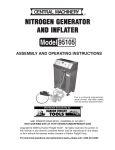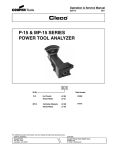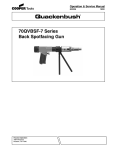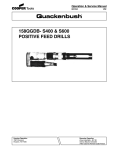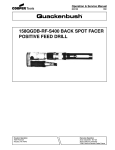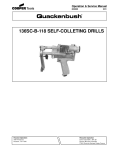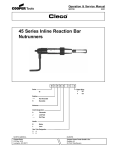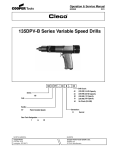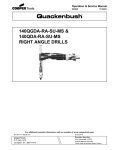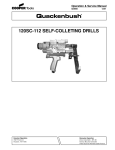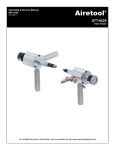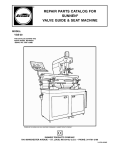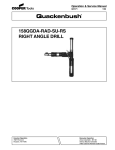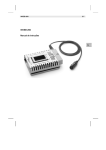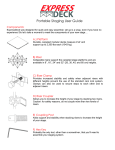Download 60QBSF-5 Series Back Spotfacing Gun
Transcript
Operation & Service Manual 823237 07/03 60QBSF-5 Series Back Spotfacing Gun For additional product information visit our website at www.coopertools.com NORTH AMERICA CooperTools P.O. Box 1410 Lexington, SC 29071-1410 EUROPE Recoules Operation Zone Industrielle - B.P.28 Avenue Maurice Chevalier 77831 Ozoir-la-Ferriere Cedex, France 1 Safety Recommendations For your safety and the safety of others, read and understand the safety recommendations and operating instructions before operating a drill. Always wear protective equipment: ! ventilation and/or wear a respirator. Respirators should be selected, fitted, used and maintained in accordance with Occupational Safety and Health Administration and other applicable regulations. Read the material safety data sheet of any cutting fluids or materials involved in the drilling process. WARNING ! WARNING Impact resistant eye protection must be worn while operating or working near this tool. For additional information on eye protection and face protection, refer to Federal OSHA Regulations, 29 Code of Federal Regulations, Section 1910.133., Eye and Face Protection, and American National Standards Institute, ANSI Z87.1, Occupational and Educational Eye and Face Protection. Z87.1 is available from the American National Standards Institute, Inc., 11 West 42nd Street, New York, NY 10036. ! Do not wear loose fitting clothes, long hair, gloves, ties or jewelry. CAUTION Personal hearing protection is recommended when operating or working near this tool. Hearing protection is recommended in high noise areas 85 dBA or greater. The operation of other tools and equipment in the area, reflective surfaces, process noises and resonant structures can substantially contribute to, and increase the noise level in the area. Excessive air pressure above 90 PSIG or worn motor components can also increase sound level emitted by tool. Proper hearing conservation measures, including annual audiograms and training in the use and fit of hearing protection devices may be necessary. For additional information on hearing protection, refer to Federal Regulations, Section 1910.95, Occupational Noise Exposure, and American National Standards Institute, ANSI S12.6, Hearing Protectors. Cleco drills are designed to operate on 90 psig (6.2 bar) maximum air pressure. If the tool is properly sized and applied, higher air pressure is unnecessary. Excessive air pressure increases the loads and stresses on the tool parts and may result in breakage. Installation of a filterregulator-lubricator in the air supply line ahead of the tool is recommended. Before the tool is connected to the air supply, check the throttle for proper operation (i. e., throttle moves freely and returns to closed position). Being careful not to endanger adjacent personnel, clear the air hose of accumulated dust and moisture. Before removing a tool from service or changing a drill bit, tap, reamer, or any accessory make sure the air line is shut off and drained of air. This will prevent the tool from operating if the throttle is accidently engaged. Sudden and high reaction torque may be experienced with any drill if: • drill motor stalls by excessive load being applied to drill bit or drill bit snags on material being drilled. • on break-through when the drill bit passes through the material being drilled. User must be prepared to resist torque. ! ! WARNING Wear respirator where necessary. Drilling operations may produce hazardous fumes and/or dust. To avoid adverse health effects utilize adequate 2 Follow good machine shop practices. Rotating shafts and moving components can entangle and entrap, and can result in serious injuries. Never wear long hair, loose-fitting clothes, gloves, ties, or jewelry when working with or near a drill of any type. CAUTION Safety Recommendations ! CAUTION • Drill bits are sharp. Handle them carefully to avoid injury. • Cutting tool maximum speed rating must equal or exceed rated speed of tool. • Drill bits or accessories not centered properly in the chuck can cause excessive wobble or vibration. • Use appropriately sized chuck key to securely tighten drill bit, tap, or reamer in drill chuck. Always remove chuck key before starting tool. • Use care when drilling because of the possibility of the cutting tool bending or breaking. ! CAUTION Tools equipped with chuck capacity over 1/4" should have at least one handle offset at a right angle to drill axis to counteract torque developed by tool. If tool is equipped with a chuck over 3/8" capacity, two handles at right angles to the drill axis should be used. One handle should contain the tool throttle, such as pistol grip or offset handle models. Always use a dead handle with low RPM — high torque tools. ! WARNING Repetitive work motions and/or vibration may cause injury to hands and arms. Use minimum hand grip force consistent with proper control and safe operation. Keep body and hands warm and dry. Avoid anything that inhibits blood circulation. Avoid continuous vibration exposure. Keep wrists straight. Avoid repeated bending of wrists and hands. Some individuals may be susceptible to disorders of the hands and arms when performing tasks consisting of highly repetitive motions and/or exposure to extended vibration. Cumulative trauma disorders such as carpal tunnel syndrome and tendonitis can be caused or aggravated by repetitious, forceful exertions of the hands and arms. Vibration may contribute to a condition called Raynaud's Syndrome. These disorders develop gradually over periods of weeks, months, and years. It is presently unknown to what extent exposure to vibrations or repetitive motions may contribute to the disorders. Hereditary factors, vasculatory or circulatory problems, exposure to cold and dampness, diet, smoking and work practices are thought to contribute to the conditions. Any tool operator should be aware of the following warning signs and symptoms so that a problem can be addressed before it becomes a debilitating injury. Any user suffering prolonged symptoms of tingling, numbness, blanching of fingers, clumsiness or weakened grip, nocturnal pain in the hand, or any other disorder of the shoulders, arms, wrists, or fingers is advised to consult a physician. If it is determined that the symptoms are job related or aggravated by movements and postures dictated by the job design, it may be necessary for the employer to take steps to prevent further occurrences. These steps might include, but are not limited to, repositioning the workpiece or redesigning the workstation, reassigning workers to other jobs, rotating jobs, changing work pace, and/or changing the type of tool used so as to minimize stress on the operator. Some tasks may require more than one type of tool to obtain the optimum operator/ tool/task relationship. The following suggestions will help reduce or moderate the effects of repetitive work motions and/or extended vibration exposure: • Use a minimum hand grip force consistent with proper control and safe operation • Keep body and hands warm and dry (cold weather is reported to be a major factor contributing to Raynaud's Syndrome) • Avoid anything that inhibits blood circulation —Smoking Tobacco (another contributing factor) —Cold Temperatures —Certain Drugs • Tasks should be performed in such a manner that the wrists are maintained in a neutral position, which is not flexed, hyperextended, or turned side to side. Avoid Extension OK Neutral Avoid Flexion Avoid Radial Deviation OK Avoid Neutral Ulnar Deviation • Stressful postures should be avoided — select a tool appropriate for the job and work location • Avoid highly repetitive movements of hands and wrists, and continuous vibration exposure (after each period of operation, exercise to increase blood circulation) • Keep tool well maintained and replace worn parts 3 Safety Recommendations WARNING ! OVER Repetitive work motions and/or vibration can cause injury to hands and arms. Use minimum hand grip force consistent with proper control and safe operation. Keep body and hands warm and dry. Avoid anything that inhibits blood circulation. Avoid continuous vibration exposure. Keep wrists straight. Avoid repeated bending of wrists and hands. CAUTION ! Personal hearing protection is recommended when operating or working near this tool. WARNING Hearing protection is recommended in high noise areas (above 85 dBA). Close proximity of other tools, reflective surfaces, process noises, and resonant structures can substantially contribute to the sound level experienced by the user. 203185 ! 203185 Impact resistant eye protection must be worn while operating or working near this tool. READ OPERATING INSTRUCTIONS Read Operating Instructions carefully. Follow the Safety Recommendations for your safety and the safety of others. Warning Labels The warning labels found on these tools are an essential part of this product. Labels should not be removed. Labels should be checked periodically for legibility. Replace warning labels when missing or when the information can no longer be read. Replacement labels can be ordered as any spare part. Do not remove this tag until the operator of this tool has read these safety precautions. Work gloves with vibration reducing liners and wrist supports are available from some manufacturers of industrial work gloves. Tool wraps and grips are also available from a number of different manufacturers. These gloves, wraps, and wrist supports are designed to reduce and moderate the effects of extended vibration exposure and repetitive wrist trauma. Since they vary widely in design, material, thickness, vibration reduction, and wrist support qualities, it is recommended that the glove, tool wrap, or wrist support manufacturer be consulted for items designed for your specific application. WARNING! Proper fit of gloves is important. Improperly fitted gloves may restrict blood flow to the fingers and can substantially reduce grip strength. 203287 This information is a compilation of general safety practices obtained from various sources available at the date of production. However, our company does not represent that every acceptable safety practice is offered herein, or that abnormal or unusual circumstances may not warrant or require additional procedures. Your work may require additional specific safety procedures. Follow these procedures as required by your company. For more information, see the latest edition of ANSI B186.1, Safety Code for Portable Air Tools, available from the American National Standards Institute, Inc., 11 West 42nd Street, New York, NY 10036. 4 OPERATING INSTRUCTIONS OPERATION The 60QBSF-5 series drills are designed to operate on 90 PSIG (6.2 bar) air pressure. The 60QBSF-5 series requires a 5/16" hose. The drill is started by depressing the trigger and is stopped by releasing the trigger. LUBRICATION An automatic in-line filter-lubricator is recommended as it increases tool life and keeps the tool in sustained operation. The in-line lubricator should be regularly checked and filled with a good grade of 10W machine oil. Proper adjustment of the in-line lubricator is performed by placing a sheet of paper next to the exhaust ports and holding the throttle open approximately 30 seconds. The lubricator is properly set when a light stain of oil collects on the paper. Excessive amounts of oil should be avoided. In the event that it becomes necessary to store the tool for an extended period of time (overnight, weekend, etc.), it should receive a generous amount of lubrication at that time and again when returned to service. The tool should be stored in a clean and dry environment. OPERATING PRINCIPLE Cycle sequence Connect the tool to the compressed air supply. Remove the nose (26). Unscrew the clamping nut (25). Insert the pilot into the spindle (10). Position the pilot into an appropriate collet. Tighten the clamp nut (25) and replace the nose (26). 1. Insert the pilot into the pre-drilled hole on the part. Place the spotfacer at the end of the pilot. 2. Make sure that the depth is correctly set (refer to the “Machine Settings”). Place the mounting base (27) is in contact with the part. 3. Press the trigger of the drill (29) to set the spindle in motion. 4. Press the moble lever (13) for carrying out the spotfacing. Release the moble lever (13) and then the trigger. 5. Remove the spotfacer and repeat the sequence for the next part. Mechanical Principle The back spotfacing unit is made up of a pneumatic motor which enables the spindle (10) to be set in motion by means of a spindle driver (18). The spindle advance is controlled by the physical effort of the operator who manipulates the moble lever (13). Machine Setting Setting the spotfacing depth Turn off the tool. Unscrew the locking nut (20) for releasing the setting. Pull the vernier assembly (22) towards the lock nut (20). While maintaining the vernier assembly pulled out, turn the adjustment nut (23) to the desired value. Each scale division is equal to 0.001‘’. After setting the spotfacing depth, release the vernier assembly (22) and tighten the lock nut (20) so that it touches the vernier assembly. Stroke Depth of Spotfacing 5 6 INDEX NO. PART NO. 1 2 3 4 5 6 7 8 9 10 11 12 13 14 15 16 17 18 19 20 21 22 23 24 25 26 27 28 29* 30* 31* 32* 33* 34* 35* 36* 38* 39* 40 42 641356 91013010 93430085 90420025 91825060 90620020 94221135 90510035 90205360 90030025 93440000 93060020 93060025 91216235 90280045 90245100 90280040 91013005 90010120 90495020 93430020 94215020 90285005 91825065 90810030 90820010 90835045 90825005 1110038 1110077 1012024 1110052 01-2518 1110079 1006577 1110134 1110892 1110053 632705 202020 DESCRIPTION Motor assembly Driver Spring Housing Ceclips Retainer Screw M4 x 5 Spindle housing Bushing Spindle Washer Fixed lever Mobile Lever Pin dia. 5 x 12 Ball thrust bearing Ball 2mm dia. Ball thrust bearing Spindle driver Needle dia. 2.5 x 17.8 Nut Spring Vernier Assembly Slotted base Lock ring Nut Nose Mounting base Nose piece Trigger Push rod Retainer ring Valve housing Tip valve Spring Screen Muffler Muffler diffuser Hose adapter 1/4 NPT Name plate Name plate drive screw (not shown) QUANITY 1 1 1 1 1 1 3 1 2 1 1 1 1 1 1 17 1 1 1 1 1 1 1 1 1 1 1 1 1 1 1 1 1 1 1 2 1 1 1 2 70100400 is the front subassembly. * Parts included in handle subassembly 1025562 Motor adapter is included in motor assembly 641356 Motor & Gear Train parts on pages 8 & 9. 7 8 9 NOTES 10 NOTES 11 CooperTools P.O. Box 1410 Lexington, SC 29071-1410 USA Phone: 803-359-1200 Fax: 803-808-6735 www.coopertools.com 12 Recoules, S.A. Zone industrielle - B.P. 28 CooperTools Cedex 77831 Ozoir-la-Ferrière 7007 Pinemont France Houston, Texas 77040 Téléphone:Phone: (33) 01 64 43 22 00 (713) 462-4521 Téléfax: Fax: (33) 01 64 40 17 17 (713) 460-7008 www.cooperindustries.com












